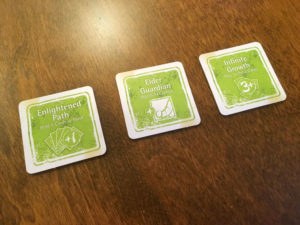 Interesting uses of area control pop up when you least expect them. Sometimes, games need no reason to justify their gameplay as long as they’re interesting. Both of these statements explain the existence of a new game designed by Jordan and Mandy Goddard from Renegade Game Studios. Debuting at Gen Con 2016, Lotus sold out at the convention, but was back on store shelves a few months after.
Interesting uses of area control pop up when you least expect them. Sometimes, games need no reason to justify their gameplay as long as they’re interesting. Both of these statements explain the existence of a new game designed by Jordan and Mandy Goddard from Renegade Game Studios. Debuting at Gen Con 2016, Lotus sold out at the convention, but was back on store shelves a few months after.
Lotus is an area control card game for 2-4 players that takes about 20 minutes to play. It plays best with 3 or 4 players.
Game Overview:
Players will play petal cards to complete and collect flowers as points. Yes, it really is that straightforward.
Game Components:
The cards, cardboard tokens and small wooden insects are good quality. The insecteeples are especially cute. The art on the petal cards themselves is gorgeous, and when a flower forms on the table, it’s easily photo-worthy.
How to Play:

After drawing their opening hands, players will take two actions a turn from the following:
Play Petal Cards: Players may play one or two cards from their hand to either start a new flower or add to an existing flower. If this completes a flower, the player who played the most points of control (icons on the cards) gains 5 points or gains an upgrade. The player completing the flower gains the petal cards, which score 1 point per card.
When players refill their hands afterwards, they can draw from their personal deck or a display of non-aligned petal cards. This has the effect of allowing faster completion of flowers at the expense of control.
Exchange Petal Cards: Players can discard one or two cards from their hand to draw two cards from their deck.
Move a Guardian (insecteeple): Players can place an insect meeple on an incomplete flower. This can be an unused insect meeple or one that’s already on another flower. These add to a player’s total when determining who controls a flower.
Once a player’s deck of petal cards runs out, each player gets one more turn. The most points from collected petals and 5 point bonus tokens wins.

Game Experience:
Playing Lotus is a joy. When the moment calls for a light game that involves lots of interactive strategy, Lotus is easily a game to consider. This doesn’t make it perfect. The flaws really come from wanting more from this experience rather than outright problems with the game.
The first thing to notice is how fast a game of Lotus plays. Turns are quick and a player’s choices are usually pretty straightforward. If a player is not sure what they want to do, it’s usually from having too many good options rather than having too few.
These strategic choices are also what makes the interactive play so great. Hand management is important because it defines whether a player is focused on a flower-completion strategy or on an upgrade & bonus point strategy. It’s also possible to be adaptable and build a hand in preparation for both.

With the way flowers score, usually a strong initial card play for a flower is necessary to make sure the bonus points will be won. Just playing a single petal card is usually weak unless it’s played to a smaller flower.
Even with this aggressive function, the game presents gorgeous art that deviates in form. Gamers turned off by testosterone-driven area control themes will find the stylistic presentation alluring, yet also be surprised that a game of such aggression is contained in the box. Players should definitely understand that there is nothing passive about the play in Lotus.
But this stylistic choice could also be seen as a negative. The theme is pretty thin. There is no reason for the game to represent flower creation other than the visual aesthetic. It looks wonderful in play, but the cards could have easily been lined up in a row. There’s no functional aspect to the petal layout.
There are also a few considerations that might drive players to think of Lotus as compost. There really aren’t a large variety of upgrades and games can feel samey from play to play. The petal control values do not have a wide range (1 or 2), and so considering the risk of playing certain cards is largely known. Also, once a flower is made, it doesn’t stay in the play environment. The gorgeous art is whisked away to the points pile and the overall effect dissipates.
Final Thoughts:

Lotus is lots of fun. The interaction between the area control and playing the last card on a flower is very interesting, while still remaining light and accessible. The choices are deep enough for strategy, but not so cumbersome that players will be hung up on the rules. It’s an easy game to recommend to any fans of area control.
Lotus is light and fast, but it hits the right notes with elegance and engagement. It won’t be the main faire for an evening, but area control fans won’t be pushing it away when it comes time for a filler.
If you’d like to pick up a copy of Lotus, you can get it for about $20.
Final Score: 4 Stars – A beautiful looking card game that plays quickly and is accessible to just about anyone.
 Hits:
Hits:
• Play time
• Engaging choices
• Fun insect meeples and gorgeous cards
Misses:
• Can feel repetitive























